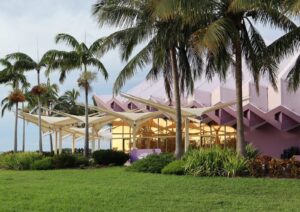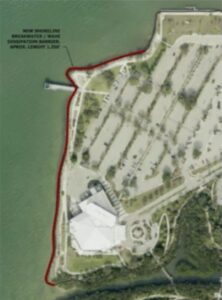Activist’s response: The historic performing arts hall is ‘iconic, perfectly sound, and very flood-proofable’.
By Johannes Werner
Original Air Date: May 16, 2025
Host: Will climate change doom the historic Van Wezel Performing Arts Hall? A panel put in charge to figure out the future of the city-owned building seems increasingly inclined to think along these lines. But an activist who wants to save the “purple cow” is pushing back. We have the details about a meeting on Friday.

Photo by Harriet Thorpe via keepthevanwezel.com.
Johannes Werner: Six members of the seven-member Purple Ribbon Committee met Friday morning at Sarasota City Hall. The panel is expected to make recommendations to the city about what to do with the historic Van Wezel Performing Arts Center, and that’s what they began to discuss for the first time in two years at that meeting. The emerging consensus: The Van Wezel must stay operational for the next few years, but there needs to be a new building to serve as a touring-act venue. And that does not bode well for the long-term future of the 1968 building whose design was inspired by Frank Lloyd Wright.
Climate activist Bob Bunting did most of the talking and set the tone during the meeting. He repeatedly said that rising sea levels and storms will doom the Van Wezel. He predicted that 2035 will be a particularly challenging year, with high tides that could add 5-10 inches to sea level rise.
Bob Bunting: Now that we know what we know, I have a strong sense that we should encourage the city to move forward on an alternate plan that’s not the Van Wezel for a performing arts center. I mean, it seems common sense to me at this point.

Some parts of the Van Wezel experienced up to four feet of storm surge during Hurricane Milton in 2024.
JW: Repeating a point he made in a previous meeting, he said the seawall protecting the building must be taken out to prevent flooding of The Bay park nearby.
David Rovine seconded him, taking a business perspective.
David Rovine: The reality of climate change and the vulnerability of the building—as an entrepreneur, investor, financial person who says, “Am I going to invest in a business that I would like to have around for 10, 20 years in this area?”—that really frightens me as an investor.
JW: Except for one of the six panel members, who said she does not share Bunting’s conclusions, everybody else seemed to be in line with the idea that the touring act function should transition out of the Van Wezel within five to seven years. Limited fixes should be made to the structure, and Robarts Arena could be kept as a backup during the transition period.
One committee member suggested that, in the face of climate change, the committee should recommend the city organize a managed retreat for all its assets.

“Keep The Van Wezel” logo.
Kelly Franklin is a community organizer who started keepthevanwezel.com. She spoke to the committee Friday morning. She calls the Van Wezel “iconic, perfectly sound, and very flood-proofable.” Franklin says neither Bunting nor Cosler are architects, builders or engineers. She believes the Van Wezel can be made resilient at a moderate cost—as outlined in a report commissioned by the city.
Kelly Franklin: What’s really frustrating me about Bob Bunting and some of the other experts on the panel—the current chair is a theatrical expert, designing the inside of a theater space, but not an architect—not an engineer. Bob Bunting is a climate scientist. He knows weather patterns. I totally defer to his expertise in that realm, but he’s ignoring the fact that this is a physical structure and a physical environment, and the expert engineers have studied it twice now. They looked at a 500-year storm, and they said, “Yeah, go spend a couple million dollars and shore up that shoreline.” And we can’t guarantee against the worst catastrophes, and they may come. But we can do the basic flood proofing that anybody should be doing if they’ve got a waterfront asset.

Photo by Harriet Thorpe via keepthevanwezel.com.
What that Karins report said is this building’s got about a 20-year life. It’s never taken on water, and it could be good to go for another hundred years or more. And they completely ignored that conclusion—Mr. Bunting did and the chair did—and they’ve been talking over and dominating that panel. What that panel didn’t speak to today is the Straz center in Tampa was damaged by the same hurricanes. It was back in six weeks, because they’ve probably weather sealed around their doors! We should do that.
JW: Bunting suggested that—if a new performing arts center is built in the same vicinity—the best location would be along U.S. 41, on higher ground, using terracing or other ways to protect the new building.
Here is Kelly Franklin’s response:
KF: The fellow that spoke at the end used to run Eckerd Theater in St. Pete, so he understands the venue, and I think he makes a good case that—if ever we are going to build another thing, whether it’s a symphony hall or a new theater or both—probably the bayfront is not the smartest place to build that. I think even Bob Bunting would agree with that.
JW: The panel will meet again May 27.
Reporting for WSLR News, Johannes Werner.
WSLR News aims to keep the local community informed with our 1/2 hour local news show, quarterly newspaper and social media feeds. The local news broadcast airs on Wednesdays and Fridays at 6pm.